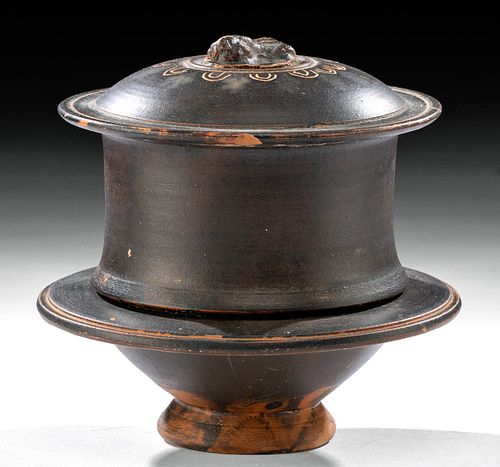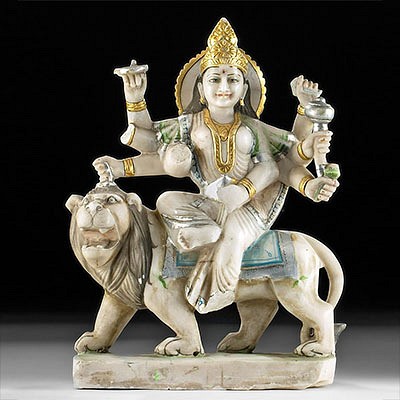Greek Hellenistic Terracotta Lidded Pyxis w/ Goddess
Lot 16a
About Seller
Artemis Fine Arts
686 S Taylor Ave, Ste 106
Louisville, CO 80027
United States
Selling antiquities, ancient and ethnographic art online since 1993, Artemis Gallery specializes in Classical Antiquities (Egyptian, Greek, Roman, Near Eastern), Asian, Pre-Columbian, African / Tribal / Oceanographic art. Our extensive inventory includes pottery, stone, metal, wood, glass and textil...Read more
Categories
Estimate:
$2,000 - $3,000
Absentee vs Live bid
Two ways to bid:
- Leave a max absentee bid and the platform will bid on your behalf up to your maximum bid during the live auction.
- Bid live during the auction and your bids will be submitted real-time to the auctioneer.
Bid Increments
| Price | Bid Increment |
|---|---|
| $0 | $25 |
| $300 | $50 |
| $1,000 | $100 |
| $2,000 | $250 |
| $5,000 | $500 |
| $10,000 | $1,000 |
| $20,000 | $2,500 |
| $50,000 | $5,000 |
| $100,000 | $10,000 |
| $200,000 | $20,000 |
About Auction
By Artemis Fine Arts
Jul 16, 2020
Set Reminder
2020-07-16 10:00:00
2020-07-16 10:00:00
America/New_York
Bidsquare
Bidsquare : Ancient / Ethnographic Art Through The Ages
https://www.bidsquare.com/auctions/artemis-gallery/ancient-ethnographic-art-through-the-ages-5334
Ancient art from Egypt, Greece, Italy and the Near East, as well as Asian, Fossils, Pre-Columbian, Native American, African / Tribal / Oceanic, Spanish Colonial, Russian Icons, Fine art, much more! Artemis Fine Arts info@artemisfinearts.com
Ancient art from Egypt, Greece, Italy and the Near East, as well as Asian, Fossils, Pre-Columbian, Native American, African / Tribal / Oceanic, Spanish Colonial, Russian Icons, Fine art, much more! Artemis Fine Arts info@artemisfinearts.com
- Lot Description
Ancient Greece, Hellenistic Period, perhaps made in Macedonia, ca. 3rd to 2nd century CE. A wheel-thrown terracotta pyxis used for holding personal trinkets and other petite items. The lower body has a broad rim atop a flared foot as well as a tall neck meant to receive the bell-shaped lid, and the rim surrounding the lid enables it to be easily removed. The bowl-slipped body features a relief bust of a goddess, perhaps Aphrodite, encircles with incised concentric arches that mimic flower petals, and incised rings adorn the rims of the upper and lower bodies. Formed via the Hellenistic painted slipware "West-Slope" technique, the brown-slipped body exhibits faint traces of fugitive white pigment which created three rings around the lid body as well as palmettes between the concentric arches on top. Size (w/ lid): 4.125" W x 3.9" H (10.5 cm x 9.9 cm)
According to the curatorial team at the Metropolitan Museum of Art, " . . . the so-called 'West-Slope" technique [is] named after the site on the Acropolis hill in Athens where pottery of this type was first identified. Distinguishing hallmarks of the technique are the use of incision, added white, and decoration with a dilute slip that produced a superposed red, pink, or orange color on top of the black-glaze ground." They also explain how pxyides like this example were perhaps, regarding their region or origin, "made in Macedonia, since other vessels with similar motifs have been found in tombs from this region. In addition to the crisply incised design on the body, the sculptured additions recall metallic prototypes that reflect the Macedonian taste for luxury items in gold and silver."
For a strikingly similar example with sculpted lion legs on the lower body and incised details on the lid walls, please see The Metropolitan Museum of Art, accession number 1979.76a, b.
Provenance: private Dere Family collection, New York City, New York, USA; private Orange County, California, USA collection, acquired before 2000
All items legal to buy/sell under U.S. Statute covering cultural patrimony Code 2600, CHAPTER 14, and are guaranteed to be as described or your money back.
A Certificate of Authenticity will accompany all winning bids.
We ship worldwide and handle all shipping in-house for your convenience.
#154188Minor nicks and abrasions to foot, neck, lower rim, upper rim, and goddess, with fading to slip and fugitive pigment, and softening to some finer details, otherwise intact and excellent. Light earthen deposits and faint but noticeable remains of original fugitive pigment.Condition
- Shipping Info
-
All shipping is handled in-house for your convenience. Your invoice from Artemis Gallery will include shipping calculation instructions. If in doubt, please inquire BEFORE bidding for estimated shipping costs for individual items.
-
- Buyer's Premium



 EUR
EUR CAD
CAD AUD
AUD GBP
GBP MXN
MXN HKD
HKD CNY
CNY MYR
MYR SEK
SEK SGD
SGD CHF
CHF THB
THB















